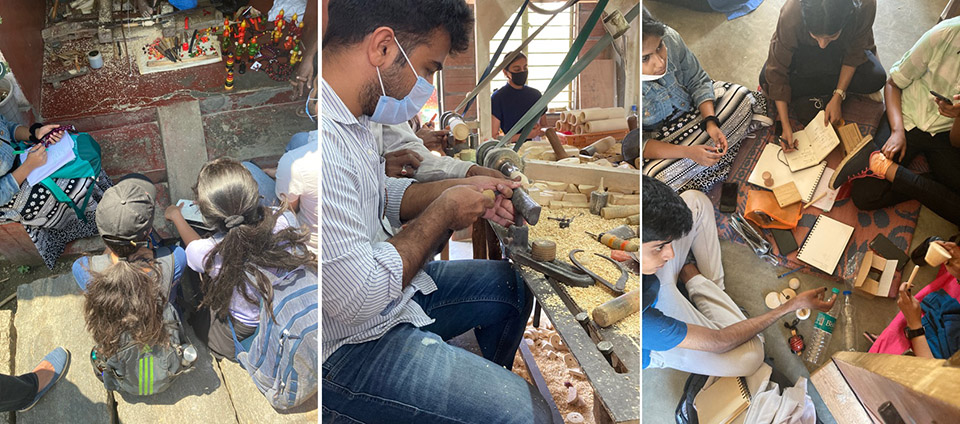“Designers of digital artifacts face a particular difficulty. The material they use— that is, the digital technology—can in many ways be described as a material without qualities… As a consequence, the design process becomes more open, with more degrees of freedom and therefore more complex.” - Jonas Löwgren and Erik Stolterman in Thoughtful Interaction Design.

Embodied learning of evolving craft ecosystems in collaboration with FairKraft Creations and ArtisanPride Producer Company, Channapatna. Image Source: Naveen Bagalkot
Vision
Human Centered Design focuses on solving complex problems keeping the human concerns at the centre. The program focuses on designing systems, services, spaces and products by exploring the possibilities and implications of shaping digital technology.
The vision is to create an interdisciplinary environment of learning that fosters a creative and located inquiry into human experiences with digital technology, both existing and emerging. Along with informed positioning, imaginative critical making remains at the core of this program, treated as a tool to ideate, tinker, play and express with digital technology.
Three closely interlinked paths define the learning space. They are
- Locating the self at specific, socio-politically contested sites that embed Human Computer Interactions. By being open to playing around with different theories and contexts, this path focuses on understanding, unpacking, and being responsive to the specific theories and contexts within which human centered design and use of digital tools and technologies is located.
- Moving Beyond Screens and towards exploring tangible, physical encounters with the digital material. This path focuses on exploring the possibilities and implications of designing digital technology as an integral part of the physical environment for human experiences.
- Moving Behind Screens, towards exploring opportunities and implications of designing for interacting with complex socio-technical infrastructures. This path focuses on exploring the design for screen-based interactions while digging deeper into the emerging complex technological infrastructure that is increasingly driving such interactions, namely big data, machine learning and advanced algorithms.
Though the undergraduate program primarily emphasizes on exploring the second and third pathways, the three paths are closely interlinked and intertwined. Each learner will have an opportunity to explore the intersections of the paths, and thereby begin to work on developing their own unique, individual practice.
Core Values
Our curriculum and its experience are guided by core values that foster a space for the development of an independent creative practice of shaping digital technology and its usage. The values are:
- Exploratory
- Hands-On
- Self-Aware
- Inclusive
- Playful
Course Structure
The curriculum comprises of different ways of learning as follows:
- Foundation introduces students to basic principles and tools of Art, Design and Technology as methods, tools and processes. Read more >>
- Disciplinary Studios are learning spaces where students develop core disciplinary capabilities, while navigating a trans-disciplinary environment
- General Studies is a common and compulsory programme of study that integrates Humanities, Sciences, Maths, business and finance. Development and Policy Studies and also offers Languages (Spanish, French and German) Read more >>
- Interim is an immersive introduction to practice in new and emerging areas of art and design and environmental exposure
- Electives are of three kinds - this program allows students to expand their skills, develop the interests as well as provide opportunities for travel exchange
- Internship/Apprenticeship is compulsory work experience done over the summer-break between the 6th and 7th semester
- Project based learning involves the application and synthesis of capabilities acquired. Two projects, pre-thesis and thesis, is culmination of the 4-year undergraduate program, which allows for demonstration of an integration of values, positions, capabilities and practice. Read more >>
Learning Approach
Learning at the undergraduate level in Human Centered Design happens through engaging and experiencing complex real-world situations. Which means learning is not bound to the physical space of a ‘studio’ or a ‘class’. Our knowledge is created in a collaborative manner, with a clear focus on hands-on making in and beyond a studio. We actively seek to play around with digital technology, making it as the objects of our inquiries, and not just apolitical means of solving problems. The learning approach encompasses engaging in and with the following aspects:
- Hands-on and critical making.
- Philosophies and methods of human centered design of digital technology and their limitations.
- Speculative creativity.
- Self-reflexivity.
Capability Sets
The complexity and the diversity of the design situations demand a pliable, customized design process. Equipped with following capabilities, we encourage our students to define and perform their own design process:
Imagine: Construct concepts in an unhindered and unbounded manner.
Speculate: Take risks while constructing plausible concepts even with limited information.
Discern & Align: Take an informed stance after perceiving, questioning, and distinguishing between information from different sources.
See & Connect: Consciously unearth and combine diverse experiences and information.
Be Honest: Be aware of and be transparent in articulating your position.
Make: Construct artifacts, things, and systems as demonstrators of ideas and concepts.
Opportunities
The above-mentioned capability sets could lead to opportunities such as:
- Employment in the Information Technology industry with a focus on user experience, user interface and experience design.
- Employment in design studios, R&D, product development teams in small and large companies focusing on novel, cutting-edge interaction and interactive product design.
- Employment in start-ups, small and medium enterprises, NGOs & social enterprises focusing on both product design and service-system design.
Furthermore, we set a platform to develop an individual practice, towards pushing the social, cultural, economic and political status quo about the role that digital technology could and should play in our lives. We expect the learners to push organizations or build organizations from the ground up that are accountable and responsible for the things they design.
People
Enquiries

Disciplinary Intersections
The course is informed by the following learning disciplines:
Visual Communication Design
Anthropology,
Sociology, Cognitive Psychology & Cultural Studies
Sustainability
Information Technology
Research and Collaboration
The students under this course will have the opportunity to work with the following centers and labs at Srishti.
Frugal Design DESIS Lab
IMPACT EDGE
LeNS Lab
Srishti Labs (Slabs)
FAQs
Human Centered Design is about keeping focus on “people” while creating products and services. It is about creating rich user experiences that aim at solving existing problems, creating delight for people and making products and services usable and useful. This enables designers to create meaningful interactions and experiences between people, designed things and the natural environment around us.
If you like to understand and work with people; love to iteratively explore solutions; create compelling product & service experiences; apply creative, critical and analytical thinking towards designing product & service experiences, and are passionate about design, then you have the right inclination towards becoming a Human Centered Designer.
The program is delivered using a combination of studios, workshops, classroom sessions, seminars, and internships along with group projects to enable deep and experiential learning. You will be working in collaborative, dedicated studio spaces throughout the program. You will gain practical skills, learn design process and theories to craft designs for future, learn to communicate concepts in compelling ways using media, and develop experience solutions that are engaging and meaningful for the end-user.
Eligibility includes any one of the following:
- National and International Boards - CBSE / ISC / IB / AICE, / A Level
- NSQF Certification Level IV completed
- State Board of Technical Education - Diploma
- High School Diploma (USA/Canada)
You will work with product and services development teams that create cutting edge products and services such as the Apple Watch or Google Maps. Your role in the team will be to: ensure that current and future user needs are met; design delightful, useful and user friendly product experiences; test product and service experiences so that they meet the users expectations, constraints and needs; research and develop new and innovative ways in which user experiences can be enriched. You will typically play a key role in a User Experience Design team or a New Product Development team.
Graduates of the Human Centered Design at Srishti Manipal Institue will be able to contribute in the areas of strategic user experience design, interaction and user-interface design at numerous MNCs, startups, R&D centers across India and abroad, involved in developing technology based products, interfaces and services. Training in HCD also opens doors in the areas of strategic design thinking and innovation.
You will learn the theories behind human behavior, design and human factors principles for creating successful digital products and services, and strategies that will make digital products and services successful in the market. Some of the typical courses that you will relate to fundamentals of human-centeredness in design, interaction design and experience design across multiple media, design research, ideation and creative concept development, creative coding, interactive data visualisation, etc. Learning at Srishti Manipal is primarily through immersive studios and workshops that provide students with hands-on experience of working with the industry on real life projects.




